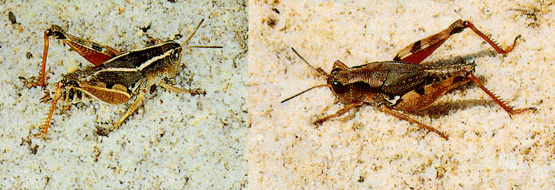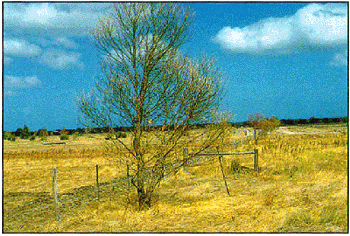Description
The wingless grasshopper adult is 13-18mm long and has two forms, with or without a pair of white stripes on each side of the thorax (see Figure 1). Most adults have short, undeveloped wings but small numbers of the population can have functional wings and are capable of considerable wind-assisted flight.
Newly-emerged wingless grasshoppers are less than 2mm long and are a uniform dark grey (see Figure 6). The identification of these hatchlings is an important part of any control program and growers would be wise to ensure that they can recognise wingless grasshoppers at this stage of their development. There are two colour forms of the wingless grasshopper shown in the image below.
Life cycle and habits
The wingless grasshopper normally has only one generation per year although under some unusual conditions there may be a second generation.
Eggs are laid in small cylindrical pods (see Figure 2). Each pod contains 10-15 eggs and is deposited 1-2cm below the surface of the soil.
Partial development of the eggs occurs after laying, before a dormant state (diapause) begins. The egg is carried through winter in this condition, and requires prolonged exposure to low temperatures before development recommences in spring in response to increasing soil temperature.
Hatching
Eggs hatch between September and November. The time of hatching depends on plant cover, topography and aspect. The relatively high soil temperatures on the crests of sandy ridges and north-facing slopes cause eggs to develop rapidly and hatch early, but eggs on well-vegetated slopes and flats hatch later because these areas are slower to warm. This creates a mosaic of hatchings which can vary over time from property to property and in some cases within a single property.
Hatching in a district may be extended over several weeks although most eggs in a particular site will hatch within a few days of each other.
The earliest emerging grasshoppers are found under marri trees on sandy ridges to the north of Perth. Other sites for detecting early emergence are around trees where there was bare, sandy ground in the previous summer, particularly on north-facing slopes and where the adults were feeding on summer-green pasture during the previous season.
It is the early, high density, synchronised hatching of grasshoppers (more than 100 per square metre) on the crests of ridges that later causes most damage.
Nymphal development
Wingless grasshoppers develop through five nymphal stages, or instars, before becoming adults. These five stages can be completed in as little as seven weeks if the spring is warm.
The first instar hoppers feed on prostrate and rosette-forming plants in pasture, particularly capeweed and flatweed. Their limited mobility at this early stage restricts feeding to the hatching site. If suitable food plants are not at the hatching site or are masked by tall pasture grasses such as ryegrass, few first instar hoppers survive.
Subsequent sequence instars (second, third, fourth and fifth) are more mobile and able to disperse from the hatching site. This dispersal is stimulated by the less acceptable dry feed and 'opening up' of the lower storey pasture as annual grasses dry off. Late instar hoppers infest larger areas and feed on a wider variety of plants than early instars.
Moisture is a critical factor for survival of the fourth and fifth instars and adults. In dry pasture the adults depend almost totally on trees for moisture and shade. Isolated trees are the most affected because they act as focal points and attract hoppers from a wide area.
Nymphs begin to develop into adults in late November and most are adult by late December. Mating commences two to three weeks after the adult stage is reached and females start laying eggs about one week after mating.
During this period there are high densities of hoppers on green, perennial pastures, and in home gardens. The females are particularly active in search for green feed as this type of food is essential for development of their eggs.
There is strong evidence that years with unusually high summer/autumn rainfall (as was the case in 1990) allow the development of more feed which results in increased wingless grasshopper populations in the following summer.
Economic significance
Wingless grasshoppers are summer pests that cause most damage when eating green feed in the late nymphal and adult stages. The peak of grasshopper activity does not coincide with the growth of annual pasture and hoppers eat only small amounts of dry matter. At a density of 30 adults per square metre, only about 10% of annual pasture in an affected area is eaten by grasshoppers. This is not enough to significantly affect stock carrying capacity. In contrast with this, the loss of perennial pasture can be very significant.
Clover germinating in summer on south coastal areas is particularly susceptible to grasshoppers until May, and grasshoppers have been known to severely damage irrigated crops and pastures, dryland lucerne, and tagasaste plantations.
Damage to native trees is common and repeated defoliation may kill mature trees (see Figures 3 and 4). The economic significance of this 'tree decline' is not known. Newly-planted trees are especially susceptible and it is unlikely than any species can survive heavy infestations without strategic grasshopper control. Some species (for example, Tasmanian blue gum, Eucalyptus globulus) appear to possess some tolerance, probably through their unpalatability to wingless grasshoppers.
Years with unusually high summer/autumn rainfall (as was the case in 1990) allow the development of more feed which results in increased wingless grasshopper populations in the following summer.
Control
Because the wingless grasshopper is not a declared insect pest, the landholder is responsible for control.
Farm management can affect the pest status of wingless grasshoppers. Avoid high stocking rates and short 'open' pastures as these encourage grasshopper outbreaks by increasing the amount of bare ground available for egg-laying.
Spraying
At present the strategic use of insecticides is the only economic method of control. Outbreaks can be prevented by spraying the early instars before they disperse from the hatching site. It is vitally important that control is carried out within three weeks of emergence; early detection and control is therefore the key to success.
Aerial application of insecticide is not generally economic but may be necessary to remove infestations from valuable crops or large favourable breeding areas. Aerial spraying organised jointly by affected landholders will minimize costs and simplify treatment of ridges that overlap property boundaries.
Spraying is most effective on newly-emerged hoppers at the hatching sites before they begin dispersing. As hatching can occur over several weeks, it is necessary to monitor likely areas from early September and spot treat as required. Look at areas where there was bare ground during the previous summer, around isolated trees, on sandy ridges and north-facing slopes.
Remember you are looking for tiny grasshoppers (smaller than a match head) which are almost black in colour (see Figure 6). Their presence can be indicated by damage to capeweed flowers, which are a favoured food at this stage.
Spraying is best carried out first thing in the morning on a day that promises to be warm to hot. This will ensure that the chemical is on the ground for a full day while the grasshoppers are active. The recommended chemicals break down rapidly and may be ineffective if left on the ground overnight.
When using a ULV mister, never allow swath widths to be greater than 50 metres as this will result in poorly treated bands in which the grasshoppers will survive.
Baiting
Bran treated with insecticide is an effective bait which can provide some protection later in the season if spraying of newly-emerged grasshoppers was not carried out. When applied on ground with little or no plant cover or on trash-free cultivated strips, the bran is available to the foraging hoppers. Apply baits where hoppers congregate or as a barrier where they move across the ground, for example, towards trees or a garden. Do not apply on thick pasture.
Provide a barrier bait treatment at least two metres wide around vegetable gardens, vineyards, orchards or tree plantations. The incoming grasshoppers then pick up the bait as they move towards their target.
Grasshoppers accept the bait better after the second instar stage because the dry matter component of their diet is increasing.
An advantage of baiting is that it is relatively specific to grasshoppers and does not harm beneficial organisms. Baits are only effective for about three days because the insecticide component degrades in sunlight, so two or three applications are required during the season.
Prepackaged bran/bait mixtures are available or alternatively you can make up your own.
Making your own baits
When preparing your own bait it is essential to mix the insecticide evenly with the bran. Spray label rates of 55 millilitres of malathion (440g/L) over each kilogram of flaky bran.
For small amounts, thoroughly mix the bran in a rubbish bin or large plastic bag, shaking well to ensure it is lump-free. Then spray the insecticide over the bran using a fine droplet sprayer, mixing intermittently. Seal the container and allow to sit overnight to allow diffusion of the insecticide through the bran before use.
For larger amounts, put the bran in a cement mixer and seal the opening with a plastic rubbish bin lid which has a hole cut in its centre. Mix the contents thoroughly and then spray the insecticide through the central hole while the mix is rotating. Bag and leave overnight before using.
The bagged bait will remain effective for 12 months if stored in a cool, dry place.
Bait distribution
The application rate for bran bait can vary from 3-12 kilograms per hectare; use higher rates where the plant cover or grasshopper infestation is more dense. The bait is most effective when applied to bare ground, for example cultivated strips or firebreaks or under trees where the grasshoppers congregate.
For small areas, distribute the bait by hand, taking appropriate safety precautions. For larger areas use a super spreader to spin the bait out, or fit a blower mister with venturi suction to blow the bran out over a 10-20m wide swath. Alternatively, trickle the bran out behind a moving vehicle.
Special considerations for tree planting
Before planting trees in known wingless grasshopper-infested areas, use insecticides for at least one or two seasons to reduce infestations. Locate and treat emergence sites. Since wingless grasshoppers do not move far, but tend to drift between tree areas and pasture, effective control over an area for at least one or two years is needed. Remove sources of infestation by locating and treating the emergence sites. Extend the treatment outwards to increase the grasshopper-free area.
Since the grasshoppers do not move freely through dense vegetation, planting trees into a crop should provide some protection for one or two seasons.
Alternatively, the movement of grasshoppers from open paddocks into plantations may be impeded by planting high density guard rows of cereal rye or triticale along the edges of shelterbelts. These also protect seedlings from wind and sandblast in the first years of growth.
Two metre-wide cultivated strips maintained on either side of tree plantings can provide ideal sites for bait placement. If fences are erected around tree plantings, the growth of a thick grass barrier between the trees and fence also reduces grasshopper movement into the planting site.
Protect existing trees by fencing them off; this encourages plant cover and reduces the amount of bare, sandy ground ideal for egg laying.
Individual trees can be protected with mesh fences or products which when placed around the trunks of young trees, prevent the grasshoppers from climbing into the foliage.





